There are two types of people in this world: those who think puffins are cute worth peering off the edge of a cliff for, and those who are wrong. If you are planning a campervan trip around Iceland and hoping to meet these colourful little legends face to beak, then you are in the right place.
This guide is built for road trippers, nature lovers, wildlife photographers, and anyone who has ever looked at a puffin picture and instantly whacked that on the bucket list. Whether you’re travelling in July under the midnight sun or squeezing in a spring escape before the crowds arrive, this puffin guide will tell you exactly where and when to go, as well as some quirky little culturalisms that you won’t want to miss.
From island colonies just off the coast of Reykjavík to dramatic cliffside hideouts in the Westfjords, we are covering it all. We will also share how to watch them safely, the best tours, campervan tips, and a few puffin facts that will make you love them even more – after all they aren’t nicknamed ‘the clown of the sea’ for nothing.
Why Puffins Are Iceland’s Most Beloved Summer Guests

Puffins are practically celebrities in Iceland. Locally known as “lundi,” these birds arrive each summer by the millions, waddling ashore to nest on cliff faces, raise their pufflings (yes, baby puffins are called pufflings), and pose for the thousands of camera clicks aimed their way.
Their bright orange beaks, penguin-like tuxedos, and clumsy charm have won hearts worldwide. But it’s not just about the looks. Puffins are also hardworking, loyal, and hilarious to watch as they try to land gracefully on windy cliffs. Spoiler alert: they usually don’t, but they certainly have an unreported talent of moving just before you take your picture.
Iceland is home to more than sixty percent of the world’s Atlantic puffins during breeding season. Which makes it the place to see them. And the best bit? You can often do it from your campervan doorstep.
When and Where to See Puffins in Iceland
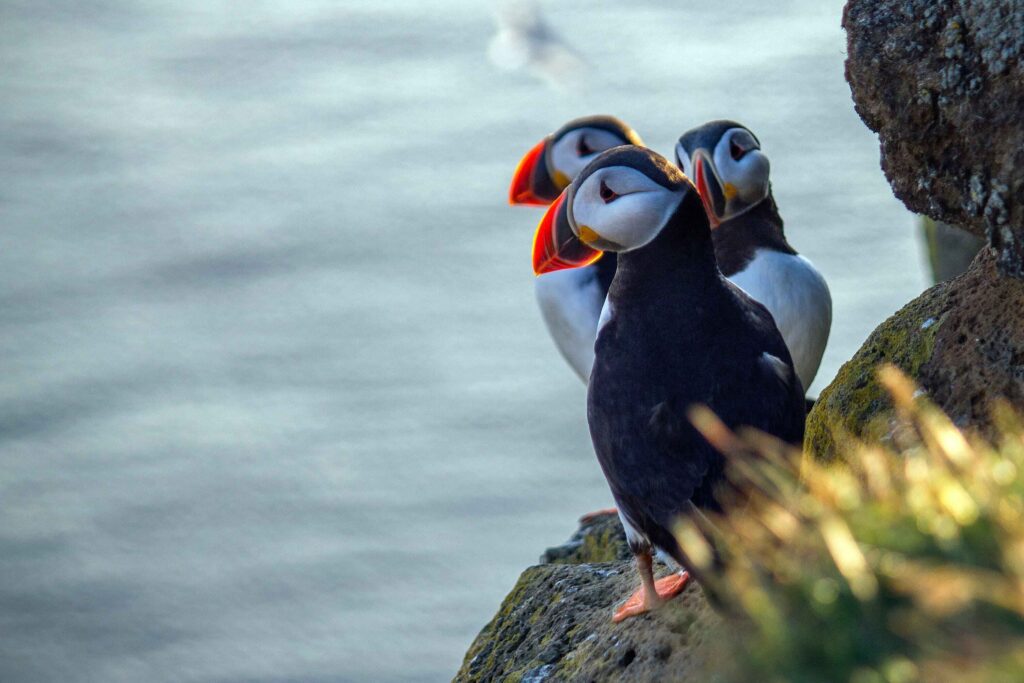
The puffin party (no, sadly not the name of a festival…that we’re aware of) kicks off in late April and lasts until around mid-August. These birds are punctual seasonal visitors. They spend most of the year at sea, but when summer arrives, they return to land to breed.
In terms of location, you are spoilt for choice. From boat-access-only islands near the capital to wild remote cliffs where you will likely share the view with more sheep than people (Iceland in general), Iceland offers a puffin-watching experience for every style of traveller.
Notoriously, the best locations to see Puffins are the following:
South Iceland
- Dyrhólaey Peninsula (Near Vík) – Puffins nest on cliff edges with dramatic coastal views.
- Reynisfjara area (Reynisfjall cliffs) – Behind the black sand beach, puffins nest in summer.
West Iceland
- Lundey (Puffin Island) near Reykjavík – Boat tours from Reykjavík harbour visit this uninhabited island.
- Akurey Island – Another puffin-viewing spot accessible by Reykjavík boat tours.
Westfjords
- Látrabjarg Cliffs – Europe’s largest bird cliff, famous for close puffin encounters.
North Iceland
- Grímsey Island – an Arctic Circle island with a large puffin population.
- Húsavík (Tjörnes Peninsula) – Puffins visible on cliffs and during whale watching tours.
- Lundey (Puffin Island) near Húsavík – Accessible via boat tours, great for puffin watching.
Eastfjords
- Borgarfjörður Eystri – One of Iceland’s best puffin-watching spots, with a viewing platform. Probably the best place to get up close and personal with these little clowns.
- Papey Island – Small island near Djúpivogur with boat tours and large puffin colonies.
Want to see them up close? Some places offer such proximity you could count their feathers (please don’t). Other spots keep things at a respectful binocular-distance, which is equally magical in the right light.
What Time of Year Can You See Puffins in Iceland?
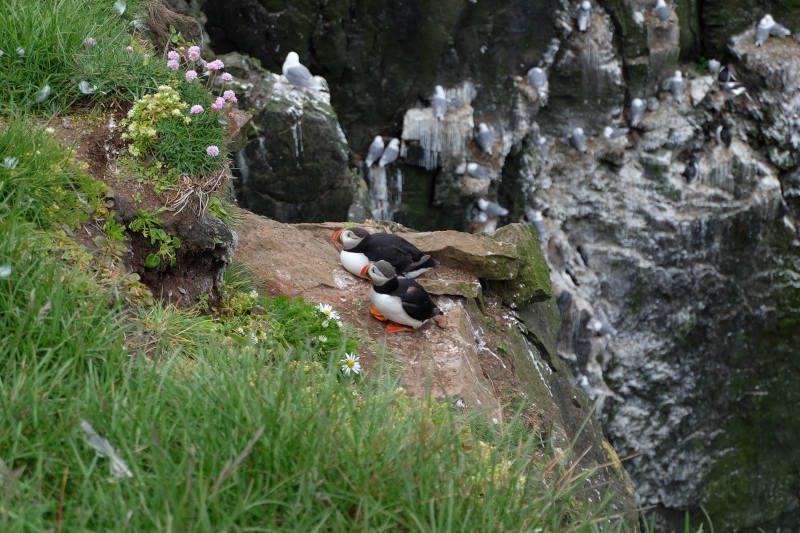
Puffins are strictly summer residents in Iceland. They begin arriving in late April or early May, returning to the same coastal nesting sites year after year. The peak viewing window is June and July, when the puffin population is at its most active and visible along the cliffs and islands.
These charismatic birds spend the rest of the year out at sea, often hundreds or even thousands of kilometres from land.
The good news? In recent years, some puffin colonies in Iceland have shown signs of recovery after previous population declines. Conservation efforts and a greater focus on sustainable tourism have helped support their fragile nesting environments.
If you are campervanning Iceland in early spring or late summer, you might still catch puffins during their arrival or departure. But for the best chance of seeing them in large numbers and active colonies, plan your trip for those golden central summer months (and bring your camera!)
Best Time of Day for Puffin Watching
Like many island-loving birds, puffins are most active early in the morning and again in the evening (very much mimicking the stirs of my cat, come to think of it). These are the golden hours when they leave their burrows for fishing runs or return with beakfuls of silver treasures for their pufflings.
This behaviour is linked to their busy parenting duties during breeding season. Puffins typically feed several times a day, flying out to sea and diving for fish, often bringing back multiple catches at once. If you spot one with a mouthful of fish, you are witnessing a hardworking parent in action.
These times of day also offer the best lighting conditions for photography. Whether you are aiming for National Geographic-level shots or just a striking new phone background, sunrise and sunset deliver warm tones, long shadows, and a bit of coastal magic that makes puffin watching even more special. If you’re a photography geek like me, I know you’ll be asking me about composition – fortunately, given where Puffins are located, that should not be a problem at all.
Puffin Behaviour: Breeding, Burrows and Pufflings
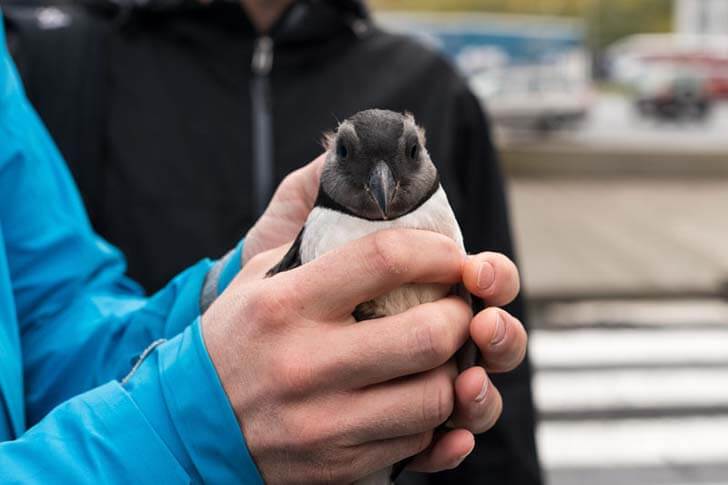
When puffins come ashore, it is all about the pufflings. They dig burrows into the grassy cliffs, pair up with a partner (often the same one year after year), and lay a single egg.
Pufflings hatch a few weeks later and are cared for by both parents. Around August, they make their first brave flight out to sea, which is a lot of pressure for a bird that looks like a flying potato.
At this time of year, on the Westman Islands, there is a cute tradition you’ll want to check out if you’re visiting towards the end of August. As the pufflings leave their nests, they can regularly make the mistake of following the town lights of Heimaey. As is this care of the local community, that for generations the children of the town gather up these lost chicks and take them to the coast to send them out to sea, fixing their little bird GPS. It’s wholesome fun, and a one-of-a-kind feel-good experience knowing you’ve helped one little puffling at a time.
Puffins are also excellent swimmers and divers, catching small fish by using their wings like flippers underwater. Their clumsiness on land only makes their underwater skills more impressive.
Top Places to See Puffins in Iceland
Near Reykjavík: Akurey and Lundey (Puffin Islands)
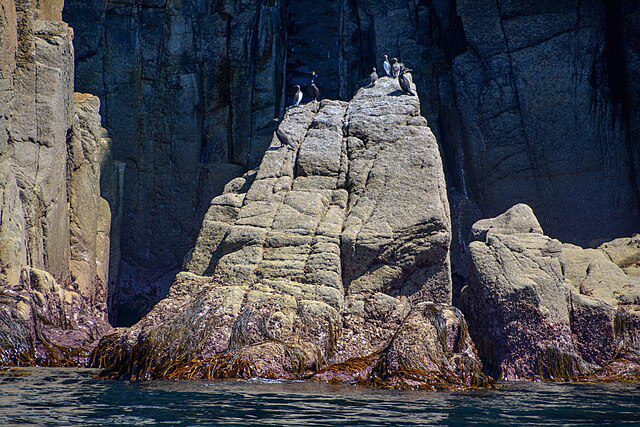 Photo Credit: Lewis Clarke via Wikimedia C.C.
Photo Credit: Lewis Clarke via Wikimedia C.C.
Just minutes from downtown Reykjavík, these small islands are home to thousands of puffins during the summer breeding season. They are part of a network of coastal nesting sites that attract puffins each year as they return from their months at sea.
You can hop on a boat tour from the Old Harbour and be watching puffins bobbing about in under an hour. These tours typically pass both Akurey and Lundey, which are known for their dense colonies of puffins along grassy slopes and rocky edges.
It is a perfect option if you are short on time, travelling with kids, or want to kick off your puffin adventure with a low-effort, high-reward experience close to town. Plus, it’s a great excuse to enjoy a day out on the water before heading back to your Reykjavík campervan base.
South Coast: Westman Islands (Heimaey)
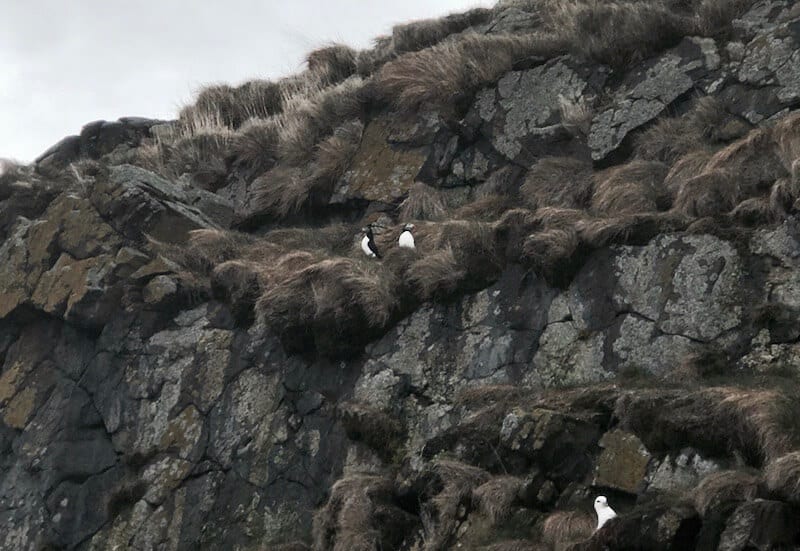
The South Coast of Iceland is puffin central. It’s my go-to place to revisit Puffins year after year, where you can guarantee incredible sightings.
The Westman Islands boast the largest puffin colony in Iceland, with over one million birds returning here each summer to nest and raise their young. These islands play a key role in the puffin’s annual migratory cycle, acting as a reliable breeding ground for generations of seabirds.
Heimaey, the largest and only inhabited island in the archipelago, is accessible by ferry and is well worth the visit. Once you arrive, the Puffin Lookout at Stórhöfði provides not only sweeping panoramic views, but also some of the most reliable puffin spotting anywhere in the country. In peak season, you will see puffins dotting the sky, perched on the grassy cliffs, and darting into burrows with fish-filled beaks.
The Westman Islands are also a stronghold of puffin conservation in Iceland, with increasing interest in protecting puffin habitats and monitoring their health through local research efforts. In fact, recent counts have shown signs of a slow rebound in puffin numbers here, a hopeful trend in a world where many seabird populations are under threat.
Southeast: Ingólfshöfði Nature Reserve
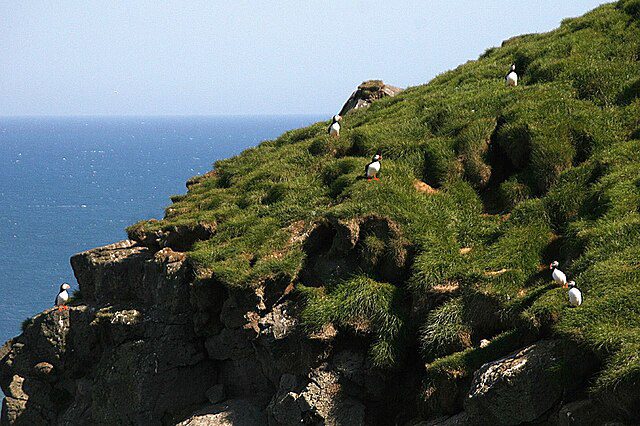 Photo Credit: Guillaume Baviere via Wikimedia C.C.
Photo Credit: Guillaume Baviere via Wikimedia C.C.
A remote and windswept headland near Jökulsárlón, Ingólfshöfði is only accessible by guided tour, which includes a bumpy ride across sand dunes in a tractor-pulled hay cart. It sounds unusual (and it is), but that is part of the charm.
Once you reach the cliffs, the real magic begins. The area is home to thriving puffin colonies that nest along the grassy ridges and steep rock faces. With fewer crowds and limited daily visitors, this location offers a quieter, more intimate viewing experience. The cliffs provide an ideal environment for puffin burrows, and during the peak summer months, you can witness thousands of birds flying to and from the sea with their catch of the day (though they never share it).
Ingólfshöfði also has historical significance, believed to be the landing spot of Iceland’s first permanent settler, Ingólfur Arnarson. So while you are admiring the puffins, you are also standing on land steeped in Viking history.
For nature lovers looking to step off the beaten track, this is one of the wildest and most rewarding puffin-viewing adventures in Iceland, and a lot less well-known.
East Iceland: Papey Island
Off the coast of Djúpivogur, Papey is a quiet island where puffins rule the roost in impressive numbers during the summer months.
To reach it, you will need to book a boat trip, which typically includes a short guided walk on the island where puffins nest undisturbed among the grassy slopes and rocky ledges. The serene atmosphere and minimal visitor traffic make this one of the most peaceful and immersive puffin encounters in the country.
Papey’s nesting season aligns with the puffin’s migratory return from the open Atlantic, where they spend the rest of the year at sea. Each summer, thousands arrive back to Papey to claim their burrows, rear their pufflings, and fill the skies with fluttering wings and low, curious calls.
It is another Puffin spot that often flies under the radar (pun intended), which makes it even more rewarding for those who venture there.
Pair your visit with a stay at Djúpivogur campsite for a relaxed base near the harbour, and let the rhythm of island life set the tone for your puffin adventure.
Eastfjords: Borgarfjörður Eystri
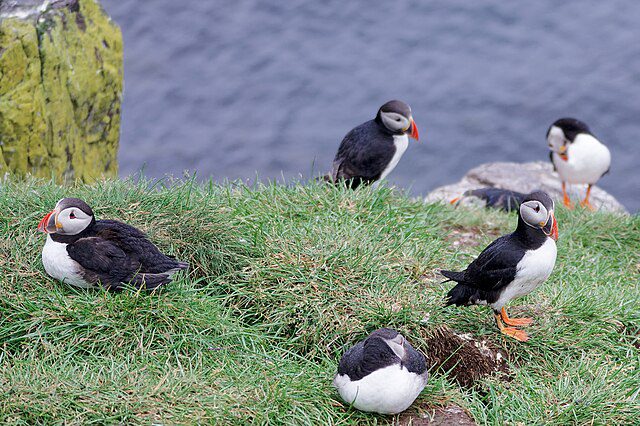 Photo Credit: Jakub Hałun via Wikimedia C.C.
Photo Credit: Jakub Hałun via Wikimedia C.C.
This colourful fishing village is one of the most accessible and consistent puffin watching spots in all of Iceland, but at the opposite enf of the country from Reykjavík it’s a long journey to reach (but a damn good one!)
Each summer, thousands of puffins return to the surrounding cliffs to nest, offering visitors the chance to witness their natural behaviours up close and in large numbers.
The Hafnarhöfn viewing platform is perfectly positioned to let you watch them without causing any disturbance, with a respectful distance that still feels personal.
Borgarfjörður Eystri is not just about the puffins either. The surrounding area is a dreamland for hikers, with trails winding through vibrant rhyolite mountains, quiet coves, and peaceful valleys. Combine that with a great campervan-friendly campsite right near the harbour, and you have one of the most rewarding places to stop, stretch your legs, and spot puffins in their natural habitat.
North Iceland: Tjörnes Peninsula
 Photo Credit: Honza and Ivana Ebr via Wikimedia C.C.
Photo Credit: Honza and Ivana Ebr via Wikimedia C.C.
Between Húsavík and Ásbyrgi, the Tjörnes Peninsula offers a scenic slice of North Iceland that feels worlds away from the usual crowds. The dramatic cliffs here are home to seasonal puffin colonies that return each year to breed and raise their young, often offering some of the most peaceful puffin viewing in the region.
As with other nesting areas around Iceland, the puffins at Tjörnes arrive in late spring and remain until mid-August, spending their off-season months far out at sea. In recent years, this part of the country has seen encouraging signs of stable or even growing puffin numbers, helped in part by reduced tourism pressure and improved nesting conditions.
A short detour from Húsavík makes this a perfect bonus stop if you have already enjoyed some whale watching or are continuing north toward Ásbyrgi canyon (known as the capital city of the elves). There are a few parking areas near the cliffs where you can enjoy views, stretch your legs, and if you’re lucky, catch sight of puffins fluttering between their burrows and the sea.
Westfjords: Látrabjarg Cliffs

If you want puffins with a serious cinematic backdrop, this is your place. But, I’ll be completely honest with you, if you have vertigo these giant cliffs are going to deliver some shaky legs (well, maybe it’s just me).
The towering sea cliffs of Látrabjarg stretch over fourteen kilometres and rise more than four hundred metres above the Atlantic (told you), making them not only one of the best puffin watching spots in Iceland, but also one of the most spectacular coastal views you will ever lay eyes on.
Each summer, thousands of puffins return to these cliffs to nest. Due to the area’s remote location and strict conservation measures, the environment remains largely undisturbed, creating a haven where the birds thrive. Puffins here are surprisingly calm around humans, often letting visitors sit within metres as they go about their daily business of fishing, waddling, and generally looking too cute for their own good (they clearly didn’t see Gordon Ramsay’s menu when he visited Iceland!)
Bring your best lens and a bit of patience. The soft evening light and dramatic cliffside views make Látrabjarg a dream for photographers and bird lovers alike. Just keep a respectful distance from the edge, as those cliffs are steep and the ground can be crumbly after rain.
West Iceland: Breiðafjörður Bay
With its scattered islands, tidal shallows, and thriving marine ecosystem, Breiðafjörður Bay is a haven for seabirds, including large seasonal puffin populations that return to nest every summer.
These puffins follow the typical migratory rhythm of the species, spending their winters at sea in the North Atlantic before making their way back to Icelandic shores around late April. As one of the puffin’s preferred breeding regions, the islands throughout Breiðafjörður offer safe, grassy terrain for nesting and are rich in food sources like small fish and crustaceans. In recent years, puffin numbers in this area have remained stable, with some colonies even showing slight increases thanks to careful environmental stewardship and limited human impact.
To experience this puffin paradise up close, hop on a boat tour from Stykkishólmur or one of the nearby villages. Many tours combine birdwatching with sea angling, storytelling from local guides, and the chance to visit remote islands steeped in history. Bring a picnic and enjoy a peaceful, scenic afternoon surrounded by puffins, pufflings, and panoramic views.
Add this to your Snæfellsnes Peninsula road trip and tick off puffins, geology, and salty sea air all in one go.
How to See Puffins in Iceland

DIY Puffin Watching vs Guided Tours
Some locations are easy to visit on your own, especially if you have a campervan. Just park, take a short walk, and you are already in puffin-viewing paradise. These self-guided options are great for those who want to take things at their own pace and soak up the coastal views for as long or as little as they’d like.
That said, some of the more remote or protected puffin habitats such as Ingólfshöfði and Papey Island are only accessible by guided tour. This is due to both limited access roads and environmental protections in place to safeguard the puffins and their nesting sites. These tours often include local knowledge, fascinating wildlife facts, and a smoother journey across sometimes tricky terrain.
If you are keen to get the most out of your puffin quest with minimal stress, a guided experience can be the way to go. You will get closer, learn more, and can often come away with better photos too, leveraging the expertise of your guides.
Safety and Etiquette: How to Respect Puffins and Stay Safe
Do not get too close or try to touch them. Stay on marked paths, avoid the edge of cliffs (they can crumble easily), and never stick your camera into a puffin burrow. That is their nursery, not your photo studio.
And yes, if you are flying a drone, keep it far away. Puffins have wings of their own. Most Puffin locations (and many locations around Iceland) will ban the use of drones, so please be aware of the signs and rules in local areas.
Puffin Photography Tips (Without Falling Off a Cliff)
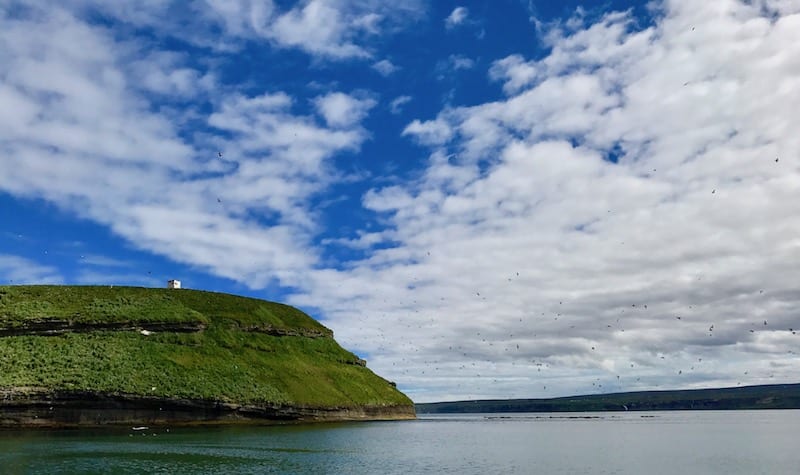
Patience is your best friend when photographing puffins. Bring a zoom lens to get crisp close-ups without needing to step too close to the edge. Golden hour, either early in the morning or later in the evening, offers not just better lighting but also more puffin activity.
If your camera settings leave you scratching your head, don’t panic. Switching to sport or burst mode often works well to catch them in action (depending on your camera), especially when they are mid-flight or hopping about. You’ll need to spend some time playing about with your shutter speed and ISO balance, in particular, unless you’re an experienced wildlife photographer.
A beanbag or compact tripod is useful for stabilising your shots on rocky or uneven terrain. You might also find yourself kneeling or crouching to get that low-angle puffin profile, so wear something you are not afraid to get a bit muddy (the same goes for your trousers). Most importantly, enjoy the experience. Puffins are charming little characters, and even if the shot is not perfect, the memory will be.
And a pro tip, if you’re anything like me, dragging around your partner who has very little patience for photography settings and lens changes, bring them a snack. This has saved me from many a domestic!
- Stay still and be patient. Puffins are curious creatures and will often come closer on their own terms if you give them space.
- Use a zoom lens to capture detailed close-ups without needing to approach the birds or their burrows. This helps keep both you and the puffins safe.
- Set your camera to a fast shutter speed to catch them in flight or during those unexpected bursts of activity. They may look awkward on land, but in the air they are quick and agile.
- Avoid flash photography and keep a respectful distance from nesting areas, especially when pufflings are present. Remember, this is their home.
- Above all, soak in the experience. Even if the lighting is off or the wind messes up your focus, being near puffins in their natural habitat is unforgettable in itself.
Best Puffin Tours in Iceland
Our Recommended Tour Operators by Region
Combo Whale and Puffin Watching Options
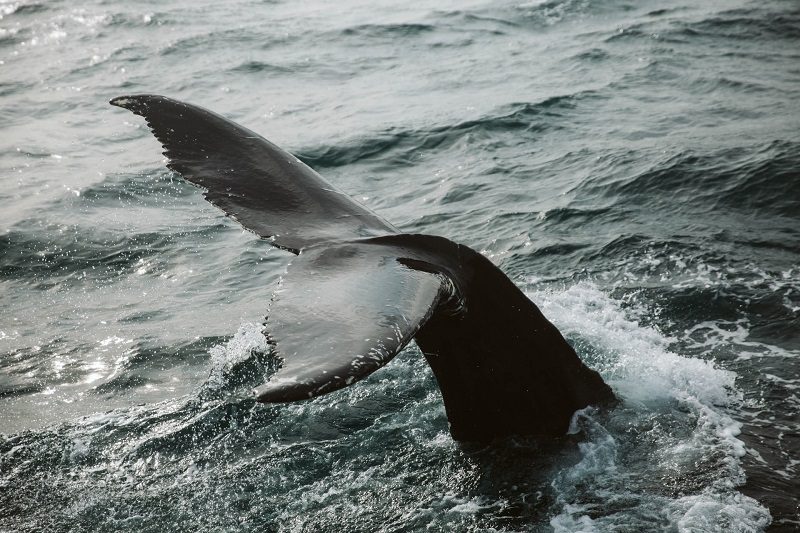
Several companies in Reykjavík and Húsavík offer combo trips. These are ideal if you want double the wildlife and half the planning.
Just be aware that whale tours tend to go farther out, while puffins stick to coastal cliffs. Ask if both are guaranteed sightings. For instance, a lot of companies will offer the chance to go on another tour if no whales are spotted on your first try (this could mean more Puffin viewing time!)
Tips for Booking (Timing, Weather, Accessibility)
Book early in summer. Always check the weather, especially for boat tours, and double-check access rules for more remote spots. Some areas require pre-booking or have restricted hours to protect the birds.
If in doubt, ask a local or one of our team members at Happy Campers HQ.
Puffin Watching Tips for Campervan Travellers
Campsites Near Puffin Spots
You will find excellent campsites conveniently close to many of Iceland’s best puffin-viewing hotspots. For a peaceful base near Papey Island, the Djúpivogur Campsite offers a great overnight spot with easy access to boat tours.
In the Eastfjords, Borgarfjörður Eystri Campsite sits right next to one of the best viewing platforms in the country and is an ideal place to rest after a day of puffin spotting or hiking in the colourful surrounding mountains.
Over in the Westfjords, Patreksfjörður Campsite puts you within reach of the iconic Látrabjarg cliffs, where thousands of puffins nest in the summer months. Each of these campsites offers a campervan-friendly experience and the chance to wake up just a short drive from a puffin colony.
Campervan-Friendly Viewing Points

Látrabjarg and Tjörnes Peninsula offer several nearby quiet roadside stops that are perfect for campervans. You can park up with a front-row seat to the puffin show, put the kettle on, and settle in for a peaceful bit of birdwatching.
These spots are particularly great in the early morning or evening when puffins are most active, so bringing a warm blanket and a camera is highly encouraged. With the right timing, these handy spots can transform into the best outdoor puffin-viewing lounges in Iceland, where the only ticket you need is a cup of coffee and a bit of patience (add sugar and milk if required).
How to Pack for a Puffin Adventure
Waterproof boots, windproof jackets, a camera with extra batteries, and a good pair of binoculars are your puffin-watching essentials. Icelandic coastal weather is famously unpredictable, so be ready for anything from blazing sun to sideways drizzle all in one afternoon. Layers are your friend for any adventure in Iceland – that and always having a spare pair of socks handy!
Snacks go a long way, especially if you are planning to perch on a cliffside for a while (not that I’m assuming you intend to directly mimic the birds). A thermos of tea, coffee, or hot chocolate makes any puffin-watching session feel more like a cosy ritual than a cold stakeout.
And please, bring a rubbish bag. Puffins may look like they belong in a cartoon, but they still live in fragile environments. Leave nothing behind but your footprints, and even those should be on the designated paths.
Why Can You Only See Puffins in the Summer Months in Iceland?
Puffins are pelagic, which means they spend most of their lives at sea. They only return to land during breeding season, which happens to be in Iceland’s short but glorious summer.
They are not hiding in winter. They are just bobbing about somewhere out in the North Atlantic, living their best seafaring lives.
The Migratory Pattern of Puffins
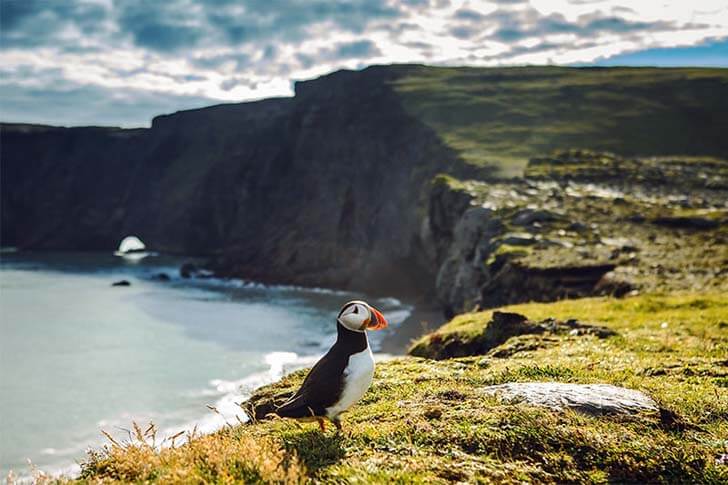
Puffins migrate huge distances and spend their non-breeding months far from shore. Their exact winter whereabouts were a mystery for years, but thanks to tracking devices, we now know they roam the open ocean between Iceland, Greenland, and Newfoundland.
And, yes, that’s right, some Puffins undoubtedly were shouting at Kate Winslet to share the door with Leonardo DiCaprio in this location.
Are Puffins an Endangered Species?
Atlantic puffins are currently listed as vulnerable due to declining populations in some parts of the world. Factors include climate change, overfishing, and pollution.
Iceland’s puffin colonies remain strong, but it is crucial to keep viewing respectful and sustainable. Every small choice helps protect them.
Conclusion
Seeing puffins in Iceland is one of those experiences that sticks with you. Whether you catch them waddling across the cliffs of the Westman Islands or peeking out of a burrow in the Eastfjords, it is a wildlife moment that feels both playful and profound.
With a campervan, you’ve got the freedom to chase puffin sightings on your own terms. Just remember to keep your distance, respect the environment, and savour every puffin-filled moment.
And if you are ready to plan your trip, check out our campervan rental options and get started. The puffins are waiting.
See you on the cliffs (I’ll be trying to keep my nerve!)
Back